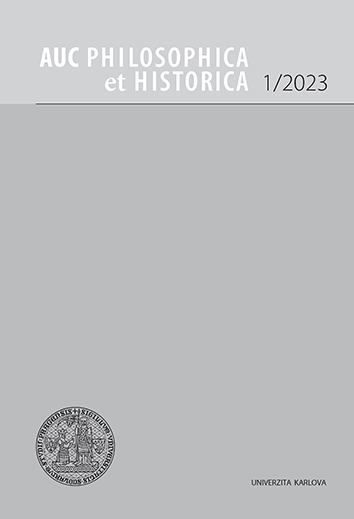AUC Philosophica et Historica je víceoborový akademický časopis zaměřený na humanitní a společenskovědné obory (filozofie, psychologie, pedagogika, sociologie, obecné, české a hospodářské dějiny, pomocné vědy historické a archivnictví, etnologie).
Časopis je indexován v databázích CEEOL, DOAJ a EBSCO.
AUC PHILOSOPHICA ET HISTORICA, Vol 2019 No 2 (2019), 237–245
Neurovědy a renesanční teorie umění
[Neuroscience and Renaissance art theories]
Liubov Marsova
DOI: https://doi.org/10.14712/24647055.2020.17
zveřejněno: 14. 09. 2020
Abstract
The article is about interactions between two disciplines: the history of art and neurology. Scientific researches in the field of neurology discover new perspectives in the humanitarian disciplines, including the art history. The article draws attention to two current themes: to the research of human empathy and mechanisms of bottom-up and topdown processing in visual perception. Those two parts the author of the article connects with the theory of art in Italy in the era of Renaissance. An unexpected comparison of discoveries in the field of neurology with the theory of the 16th century demonstrates, how useful can be the cooperation of the two disciplines. In the end of the article are proposed questions and tasks, with which the art history can deal in the light of scientific discoveries.
klíčová slova: bottom-up processing; top-down-processing; visual perception; Renaissance; neurology
reference (34)
1. Leon Battista Alberti, O malbě a.d. 1435: [Tři knihy]; O soše a.d. 1464 (Della pittura, della scultura), Praha 1947.
2. Aristoteles, Poetica, Praha 1962.
3. David Efimovič Arkin - Boris Nikolajevič Ternovetz (edd.), Mastera iskusstva ob iskusstvě, v 4 tomach, Moskva - Leningrad 1937, sv. I.
4. Rudolf Arnheim - Vjačeslav Pavlovič Šestakov (edd.), Novyje očerky po psychologii iskusstva, Moskva 1994.
5. Lina Bolzoni - Federica Pich, Poesia e ritratto nel Rinascimento, Roma 2008.
6. Jodi Cranston, Dialogues with the beholder: The poetics of portraiture in the Italian Renaissance, Cambridge 2000.
7. Vincenzo Danti, Il primo libro del trattato delle perfette proporzioni di tutte le cose che imitare e ritrarre si possano noc l'arte del disegno. Di Vincenzio Danti, Florenz 1567.
8. Lodovico Dolce, Dialogo della pittura, Venezia 1557, s. 226. - Rensselaer W. Lee, Ut pictura poesis: the humanistic theory of painting, The art bulletin XX, 1940, č. 4, s. 197-269, pozn. 92. CrossRef
9. Mark J. Fenske - Elissa Aminoff - Nurit Gronau - Moshe Bar, Top-down facilitation of visual object recognition: object-based and context-based contributions, Progress in Brain Research CLV, 2006, s. 3-18. CrossRef
10. Marsilio Ficino - Nina Revjakina (edd.), Kommentarij na Pir Platona, in: Vasilij Zubov (ed.) Istorijam estetiky. Pamjatniki mirovoj estetičeskoj mysli, Moskva, 1962, Kap VII.
11. David Freedberg - Vittorio Gallese, Motion, emotion and empathy in esthetic experience, Trends in Cognitive Sciences XI, 2007, č. 5. CrossRef
12. Vittorio Gallese - Giacomo Rizzolatti - Leonardo Fogassi, Zerkalnaja časť mozga, V mire nauki III, 2007.
13. David Ganz, Tra paura e fascino: La funzione comunicativa delle immagini visive nel "Discorso" di Gabriele Paleotti, Heidelberg 2000.
14. Ernst H. Gombrich, Umění a iluze, Praha 1985.
15. Quintus Flaccus Horatius - Dana Svobodová - Eva Stehlíková (edd.), De arte poetica: O umění básnickém, Praha 2002.
16. Eric R. Kandel, Věk samopoznanija. Poiski bessoznatěľnogo v iskusstvě i nauke s načala XX věka do našich dnej, Moskva 2016.
17. Eric R. Kandel, The age of insight: The quest to understand the unconscious in art, mind, and brain, from Vienna 1900 to the present, New York 2012.
18. Ladislav Kesner, Dějiny umění a teorie mysli, Umění LVI, 2008, č. 1.
19. Ernst Kris - Ernst H. Gombrich, The principles of caricature, Cambridge 1938.
20. Gaius Plinius Secundus - Václav Prach (edd.), O umění a umělcích, Praha 1941.
21. Giovanni Paolo Lomazzo, Trattato dell'arte della pittura, scoltura et architettura, Milano 1584, sv. I.
22. John Onians, Neuroarthistory: From Aristotle and Pliny to Baxandall and Zeki, New Haven 2007.
23. Erwin Panofsky, Idea: k istorii ponjatija v teorijach iskusstva ot antičnosti do klassicisma, Sankt-Peterburg 2002. (České vydání: Idem, Idea: Příspěvek k historii pojmu starší teorie umění, Praha 2014.)
24. Federica Pich, I poeti davanti al ritratto: Da Petrarca a Marino, Lucca 2010.
25. Gianni Carlo Sciolla, Primato del disegno: un dibattico accademico nel Rinascimento, in: Annamaria
26. Petriolo Tofani - Simonetta Prosperi Valenti Rodino - Gianni Carlo Sciolla (edd.), Il disegno: Forme, tecniche, significati (I), Torino 1991.
27. John K. G. Shearman, Only connect: Art and the spectator in the Italian Renaissance, Princeton 1992. CrossRef
28. Vilayanur Subramanian Ramachandran, The Emerging Mind, London 2003.
29. Vilayanur Subramanian Ramachandran, The Tell-Tale Brain: A Neuroscientist's Quest for What Makes Us Human, New York 2010.
30. Vilayanur Subramanian Ramachandran, Mozg rasskazyvaet: Chto delaet nas liud'mi, Moskva 2014.
31. Giorgio Vasari - A. I. Gabričevskij - A. I. Venediktov (edd.), Žizněopisanija naibolee znamenitych živopistcev, vajatelej i zodčich, polnoje izdanije v odnom tomě, Moskva 2008.
32. Leonardo da Vinci - A. A. Guber - V. K. Šilejko - A. M. Efros (edd.), Izbrannyje proizvedenija v 2 tomach (podle vydání 1935), Moskva 2010, díl 2.
33. Heinrich Wölfflin, Osnovnyje ponjatija istorii iskusstva. Problema evolucii stilja, Moskva 2009.
34. Federico Zuccaro, L'idea de' Pittori, Scultori et Architetti (p. 2), Torino 1607. Viz: http://gallica.bnf.fr/ark:/12148/bpt6k1119027, vyhledáno 24. 8. 2017, sv. II, kap. 15.

Neurovědy a renesanční teorie umění is licensed under a Creative Commons Attribution 4.0 International License.
